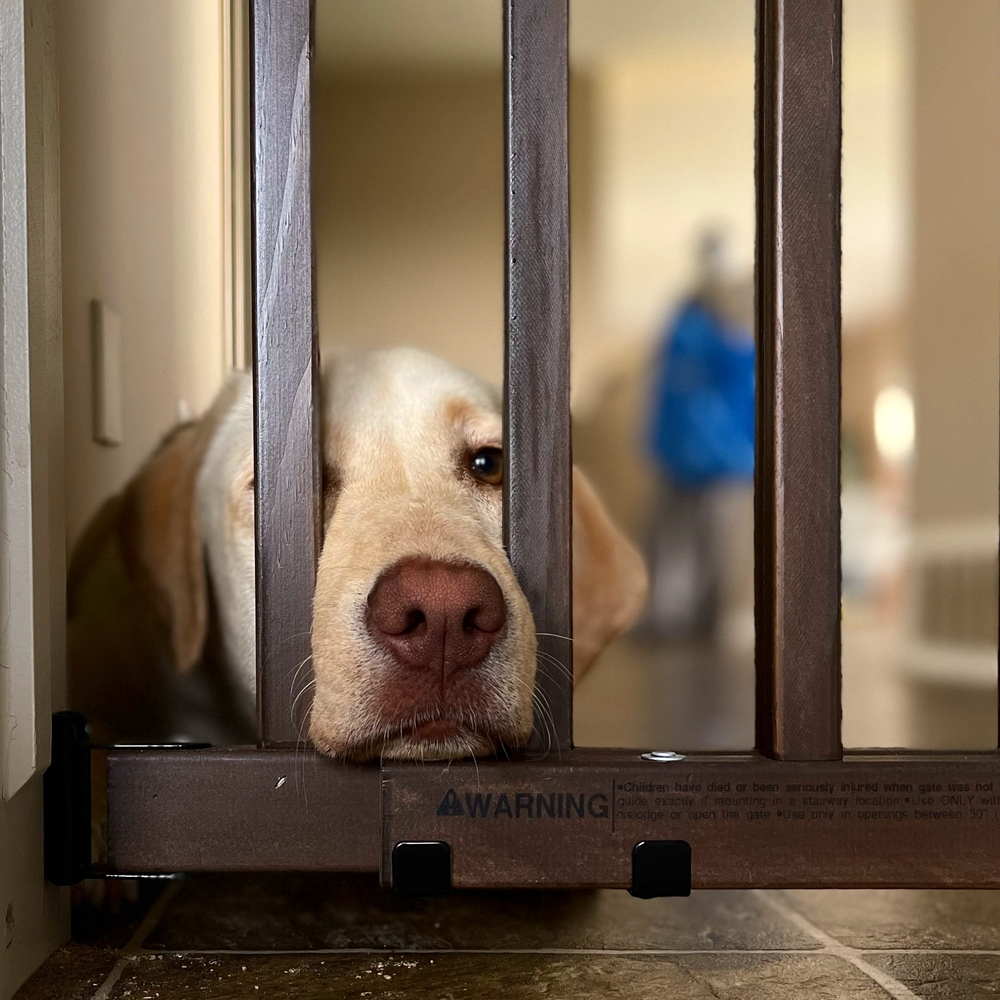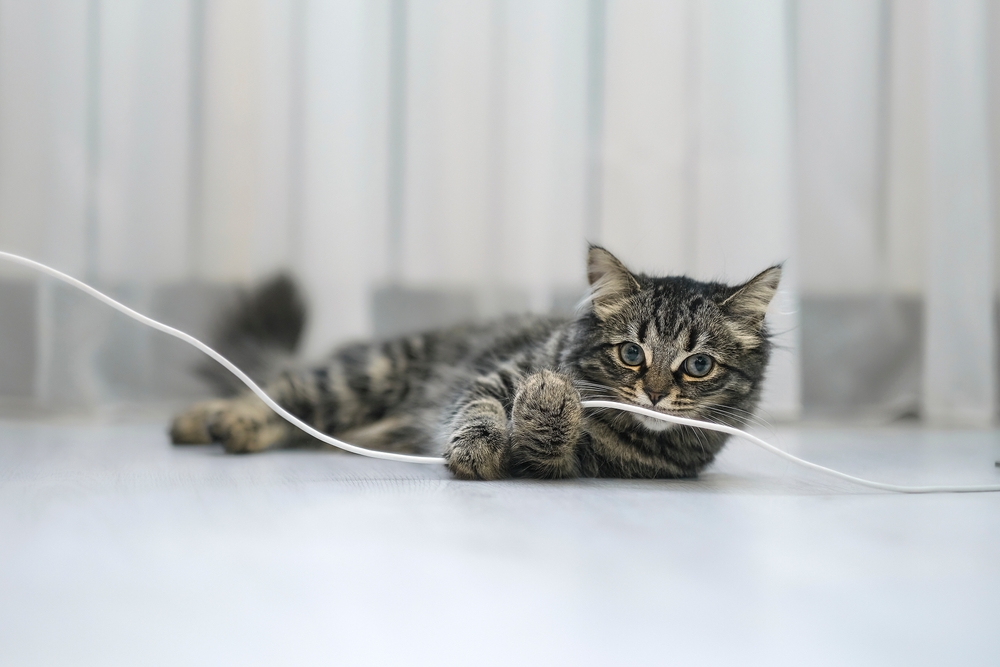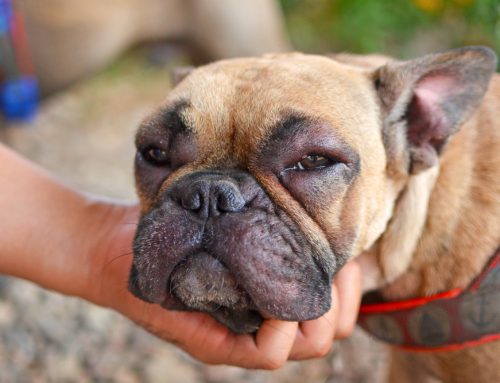Although they may think their homes are relatively safe for their pets, many pet owners are unaware of the common home hazards their furry pals encounter every day. Read our All Creatures Animal Hospital team’s pet-proofing tips to learn how to keep your pet safe at home.
Put away electrical cords your pet could chew
Many pet owners neglect electrical cords when pet-proofing their homes. Remember, pets explore their world through their mouth, and young pets especially enjoy chewing anything they can find. Eliminate this potential pet danger by covering cords in chew-proof covers or protectors. You can also spray cords with pet-safe taste deterrents to discourage your pet from chewing them.
Put pet locks on your cabinets
Cabinets are important for storing items such as food, medicine, and cleaning supplies. While you may assume that keeping your cabinets closed is enough to deter your pet from accessing items kept within, think again. Pets are amazingly resourceful at figuring out how to open cabinet doors—especially if they are convinced something tasty is inside. To ensure your pet cannot access dangerous medications, foods, and cleaning products, secure your cabinets with pet locks. To help protect your furry pal, keep the following items out of their reach in cabinets with pet locks:
- Medication — Many over-the-counter (OTC) and prescription medications for people are highly toxic to pets, including nonsteroidal anti-inflammatories (NSAIDs), acetaminophen (e.g., Tylenol), decongestants, anti-anxiety and antidepressant medications, heart and blood pressure medications, and attention deficit disorder (ADD)/attention deficit hyperactivity disorder (ADHD) medications.
- Toxic foods — Many human foods can be harmful to pets, such as xylitol (i.e. a sugar substitute), chocolate, alcohol, grapes and raisins, macadamia nuts, and Alliums (e.g., onions, chives, garlic, and leeks).
Pet-proof your yard
Pet-proofing extends beyond your home’s confines. Your yard should be a safe haven in which your pet can freely run, sniff, explore, and play. To maintain your peace of mind when your pet is in your yard, take these safety measures:
- Preventing escape — When you fully enclose your yard, your dog can enjoy playing outside with little risk of getting loose and hit by a car, stolen, or lost. A sturdy fence—high enough that your pet cannot jump over—is the safest way to keep them in the yard. Inspect the fence perimeter often for potential escape routes such as broken fence sections, or gaps between the fence and the ground. To provide your cat fresh air while keeping them safe, install an enclosed outdoor catio (i.e., cat patio).
- Planting pet-friendly foliage — You may be unaware you are growing plants in your yard that are poisonous to your pet. Many common landscape plants are toxic to pets. If you are not sure which plants are safe for your pet, take a look at the American Society for the Prevention of Cruelty to Animals (ASPCA) Poisonous Plant Guide. Toxicity effects can range from mild gastrointestinal (GI) upset to life-threatening organ damage, so avoid these poisonous plants when planning your landscaping:
- Autumn crocus
- Azalea
- Cyclamen
- Kalanchoe
- Lily
- Oleander
- Dieffenbachia
- Daffodil
- Lily of the valley
- Sago palm
- Hyacinth
- Avoiding pesticides and fertilizers – Many chemicals in lawn and garden treatments can cause pets problems, including skin burns, GI upset, or life-threatening toxicity. After your yard is treated, keep pets off the grass until the chemicals have dried, or for the manufacturer-recommended waiting period. A better strategy is to ask your lawn treatment company to use only pet-safe products. Lawn and garden pesticides may not be safe for you or your pet, so choose organic options, such as pest-deterring plants or chemical-free bug traps.
Hang backpacks and purses out of your pet’s reach
When you get home from a long day, carelessly tossing your belongings by the door is easy. However, by doing this, your pet can easily rummage through them, finding harmful contents such as xylitol-containing gums, mints, and candies, prescription medications, or pain relievers. To prevent your pet from being tempted to nose around your belongings, take a moment to hang up your bag when you arrive home.
Use pet gates to block access to dangerous areas

Set up gates to prevent your pet from trying to get to your home’s areas that could be dangerous, such as stairs, the kitchen, or the fireplace. You can also use pet or baby gates to keep your furry pal secure when entertaining guests or on holidays, such as Halloween, which involve constant door opening.
Your home is your pet’s world. Help ensure their safety by enhancing your pet-proofing routine. If you have additional questions about pet-proofing your home, or to schedule your pet’s wellness exam, contact our All Creatures Animal Hospital team.














Leave A Comment